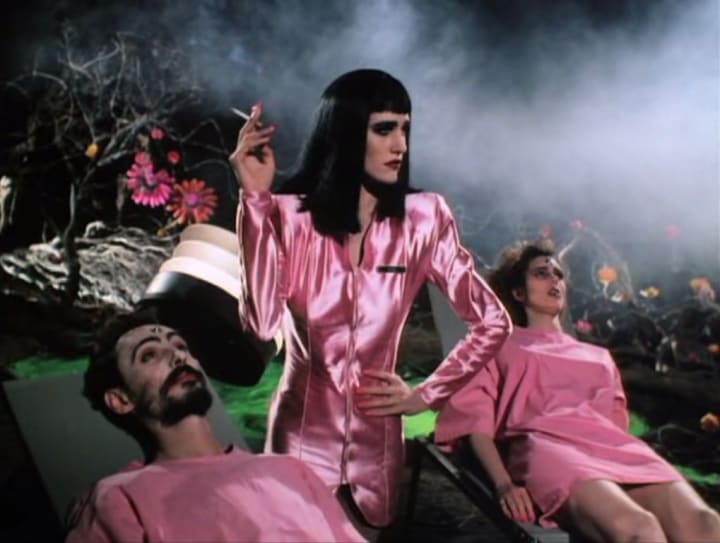
The surrealist horror film Dr. Caligari (1989), featuring erotic actresses such as Madeleine Reynal and Laura Albert, is a neon-and-plastic, sex-infused nightmare oddity belched up from the fetid guts of the late Reagan era, a videocassette relic of the bygone days of little corner stores peddling cheap, direct-to-VHS "grand guinol" for the eager lines of bored, potato chip munching thrill seekers.
The film, directed by porn director Stephen Sayadian, while not reaching the gutter levels of pure, backyard movie depravity proffered by such titles as Night Train to Terror and Desperate Living, gives the viewer enough bizarre sleaze to make it worth the time of those whose base instincts must be titillated. The casual lurker looking for cheap thrills, however, may be disappointed to realize that Dr. Caligari is not a raunchy sex and violence assault in the traditional sense, but, instead, an avant garde, fever dream melange of splatter, porn, horror comic, social satire, and "Pee Wee's Playhouse." (Or, at the very least, some other forgotten, albeit demented children's program from the era.)
"Les Van Houten" (stunning actress Laura Albert), lives in an alternate universe which looks like a filthy, disused television studio sound stage, decorated to look like the surface of a degraded alien world. Here she runs around mostly bare-breasted, receiving messages from a television, getting licked by a giant tongue, and having a weird, spewing orifice of some sort vomit onto her. She's apparently a nymphomaniac, and her dialogue is a bizarre patois of strange, non-sequitur lines and cutesy, sing-song style slang terms and stream of consciousness observations that sound as if a third-rung Dadaist poet pulled them at random from a sack, to place them in dialog balloons for the world's weirdest graphic novel ("I see my face and I'm a love slut, uh-huh," she intones at one point, looking directly into the camera, and cocking her head as if choreographed). Her husband (Gene Zerna), a weak, nerdy and nervous man who apparently can't cope with having an insanely sexy and insatiable (if undeniably mad) wife, telephones Dr. Caligari (the equally stunning Madeleine Reynal), informing the good Doctor that his wife is "slipping again." The Mad Nympho is becoming dangerous, brandishing a razor, demanding sex while spewing hallucinatory gibberish.
The movements of the actors and actresses in Dr. Caligari are carefully posed and choreographed, so that they almost form a modern dance. People puff their cigarettes unnaturally, pose in rigid, uncomfortable positions, as if for a painter or sculptor. The set itself is claustrophobic, dark; very little can be seen. Doorways are false and look plastic, are stretched to crazy, cartoon-like, dream-like angles. Everything has a sleazy, cheap, neon 1980s vibe.
Dr. Caligari has an asylum of lobotomized loonies. One of these, Gus Pratt (John Durbin), obviously modeled on Albert Fish, holds forth with the same sort of weird, reading-from-a-cue card spiels as Mrs. Van Houten, describing instead his "pokey globes" being filled with needles. He is quite obviously modeled on Fish, the infamous early Twentieth Century serial cannibal child killer, as he describes cannibalizing a young girl named "Grace." He also claims to be thrilled at the prospect of being given electro convulsive therapy by Caligari.
Caligari is apparently concerned with exchanging "brain fluid" from one patient to another. A couple of medical students, Mister and Ramona Lodger (Dave Perry and Jennifer Balgobin), recently wed, visit with Lodger's father "Dr. Avol" (played by veteran character actor the late Fox Harris), protesting Caligari's plans. Avol invites them to a strange, Eraserhead-like dinner of sheep "trotters" (legs), that must be shaved before being consumed raw.

There is nothing really conventional here about the plot. Caligari kidnaps Van Houten's husband, making him wear a dunce cap and ruff; exchanges brain fluid between Van Houten and Pratt, making Pratt mock a feminine character while Van Houten becomes a crazed cannibal; and furthermore feminizes Dr. Avol, who engages in cunnilingus and foot-licking with Caligari, dressed in a cheap wig and skirt.
The end seems to be a nosedive into the purely surreal waters of dream-like cinematic expression, as the lobotomized patients, and the main characters, who are now psychologically "exchanged" with their partners, wander about in the darkness as if they escaped from an old George Romero zombie film.
Dr Caligari is of course a satire, a live-action cartoon, mocking the world of high-tech sleaze and television communication, which is direct to the "retina of the mind's eye" as they might have said in the equally satirical, but entirely different in tone early Eighties surreal splatter thriller Videodrome. The sordid underbelly of psychiatry, which is likened unto cannibalism, and the impact of erotic violence on the casual television viewer all collide, here, with a cultural artifact left in the dust many, many decades ago. It was a world when television, not cyberspace, seemed to be the indomitable ruling tyrant dictating the "topography of the neural landscape" (to borrow a term from J.G. Ballard), going into a future we could have, at the time, never have guessed possible. Alas, television seems to now have been simply a station of the evolutionary ascent to how we, currently, live our lives.
The problem here, of course, is that an striking image might occasionallyswim to the surface in all the blackness and confusion, but, like a dream, it will wash away in the mind's eye before it has had a chance to take root. There is a curious lack of anything to hang attention on for very long, and so the film feels as hallucinatory and dreamlike as intended, but this is not to say that every dream retains some interest or value for the dreamer.
Strange and avant garde, but, perhaps, it is too alienating, because of its claustrophobic cinematography and aforementioned high strangeness, to really catch the imaginations of many viewers; this film will, however, appeal to those seeking a glimpse into a grungey backwater of cinematic offal, one coming out of the video store time warp of childhood and yesteryear. (And, also, the gorgeous actresses are really a plus.)
As to what they were trying to accomplish, and what it all truly means? That is anyone's guess.
About the Creator
Tom Baker
Author of Haunted Indianapolis, Indiana Ghost Folklore, Midwest Maniacs, Midwest UFOs and Beyond, Scary Urban Legends, 50 Famous Fables and Folk Tales, and Notorious Crimes of the Upper Midwest.: http://tombakerbooks.weebly.com






Comments
There are no comments for this story
Be the first to respond and start the conversation.